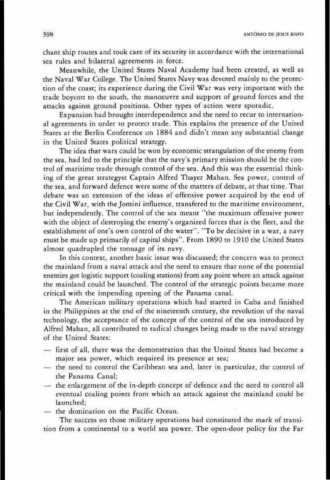Page 432 - 1992 - XVIII Congresso Internazionale di Storia Militare
P. 432
398 AmO NIO DE JP.SUS BISPO
cham ship routes an d rook care of ics sccuricy in accorda n ce with thc internacional
sea rules and bilatera( agreemenrs in force.
Meanwhile, the Uniced Scares Naval Academy had been crearcd, as wc.ll as
the Naval War CoUege. The Unired Srares Navy was devoted mainly to rhe prorec·
rion of che coasc; ics expcrience during che Civil War was very importa m with the
tradc boycon co the souch, thc manoeuvre and suppon of ground forccs and che
attacks againsr ground posirions. Other cypes of action were sporadic.
Expansion had brought interdepcndence and the need co recur to imernarion·
al agr~ments in order ro protect rrade. This explains che presence of che United
States at thc Berlin Conference on 1884 and dic.ln't mean any substantinl change
in che Unitcc.l Stares politica( mategy.
The idea rhar wnrs could be won by economie scrangulacion of the enemy from
the sea, had led co che principle that the navy's primary mission should be che con·
rrol of maririmc cradc through conrrol of rhe sea. And this was rhe essenrial rhink·
ing of the great srrarcgyst Cnprain Alfred Thaycc Maban. Sea powcr, contro( of
che sea, and forward defencc were some of the marcers of debate, ar that t ime. Tha1
dcbatc wns an cxccnsion of che idcns of offensive power acquircd by che end of
rhe Civil War, with rheJomini inOuence, transfered co rhc maridmc environment,
but indcpendendy. The concrol of che sca. meanr "che maximum offensive powcr
wich the objccc of desuoying thc cncmy's organized forces rhat is che Occt. and rhc
establishment of onc:'s own control of rhe wa.cer". "T o be decisive in a w1u. a navy
musr be made up primarily of capimi ships". From 1890 co 1910 thc Unitcd Sraccs
almost quadrupled rhe ronnage of ics nnvy.
In this contcxt, nnocher basic issuc was discussed; che conccrn was co prorecc
che mainland from a naval attack and thc need co ensure thac none of che potential
cnemics gm logistic suppon (coaHng srations) from nny poi ne wherc an armck ng.1inst
thc mainland could be launchcd. The contro l of the sera regie points became more
criticai wirh thc impcnding opcning of the Panama canal.
The American milirary opcrat.ions which had staned in Cuba and fìnished
in the Philippines a t the end of the ninetecnth cenrury, the revolurion of rhe naval
rcchnology, che acceptancc of rhc conccpt of thc contro( of che sea inrroduccd by
A.lfrcd Mahan. ali contribuced co radica( changes being made to rhe naval strategy
o( thc Unired Staccs:
fìrsr of ali, therc was che demonsrracion thac rhe United Smces had become a
m11jor sea power, which required its prcscnce at sca;
che nced co contro( rhe Caribbcan sca and, larer in particular, thc control or
the Panama Canal:
the enlargement of che in-depch concepr of defencc and Ùle need co conrrol ali
evcntual coallng poi-nts from which an artack againsc thc mainland could be
launchcd;
che domination on che Pacific Ocean.
T hc succcss un thosc milìtary operacions ha d Cl>nstiruced the ma.rk of cransi·
rion from a concinemal co a world sea power. Thc open·door policy for che Far

